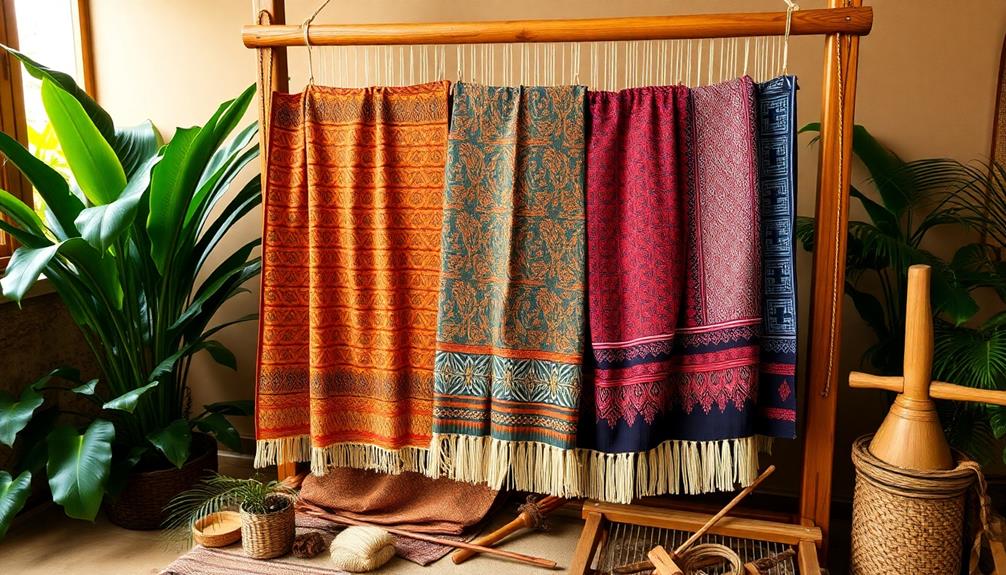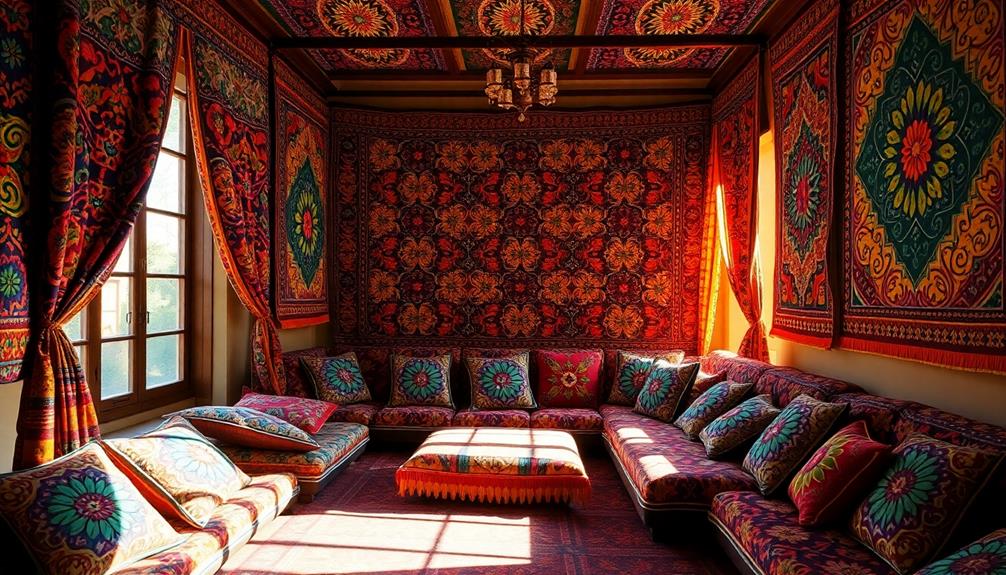Designers are obsessed with traditional Indonesian fabrics like batik, ulos, and songket because they embody rich cultural histories and stunning craftsmanship. Each fabric tells a unique story through its intricate patterns and vibrant colors, connecting you to heritage and identity. Batik's royal roots and songket's luxurious threads inspire modern aesthetics, while ulos carries deep cultural significance. As sustainability becomes a priority, these textiles align with eco-friendly practices and the slow fashion movement. You'll discover how these fabrics evolve and maintain relevance in contemporary fashion as you explore their origins and influence further.
Key Takeaways
- Traditional Indonesian fabrics like batik, ulos, and songket offer rich cultural narratives, enhancing storytelling in modern fashion designs.
- Their unique, intricate patterns and vibrant colors allow designers to create visually striking collections that stand out in the fashion market.
- Collaborations with local artisans ensure authenticity and sustainability, aligning with ethical fashion principles that resonate with today's conscious consumers.
- The fusion of traditional craftsmanship with contemporary aesthetics inspires innovative designs that appeal to younger audiences while preserving heritage.
- Celebrity endorsements and global recognition elevate these fabrics' status, making them desirable for high-end fashion and luxury markets.
Historical Roots of Batik
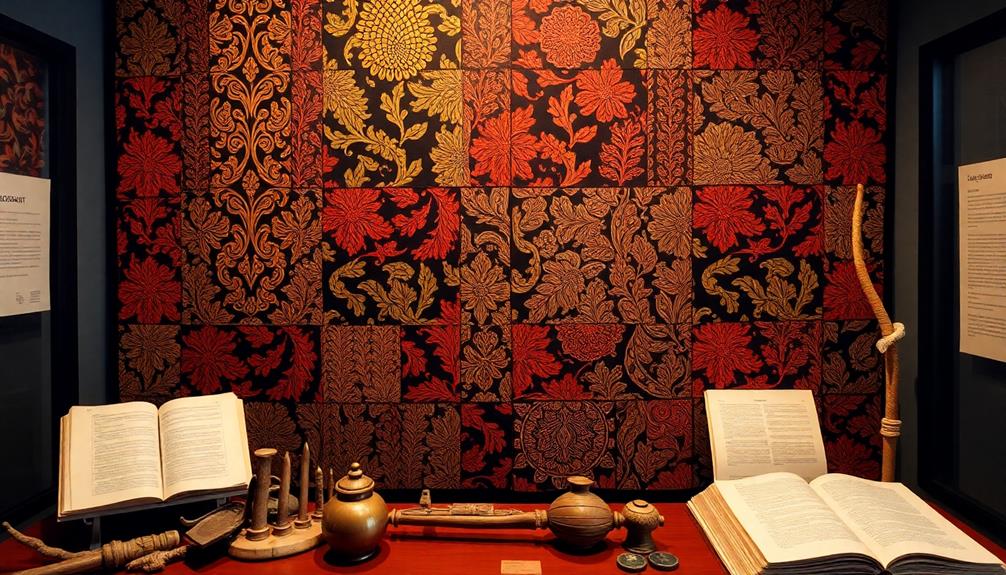
Batik, a vibrant fabric with a rich history, traces its origins back over 1,000 years, weaving together influences from Egypt and the Middle East before flourishing in Indonesia.
You'll find that batik truly gained prominence in Javanese royal courts over 300 years ago, where it was reserved for royalty. Specific patterns were designated for nobles and important ceremonies, reflecting social status and cultural significance. The artistry involved in creating batik is similar to that of traditional Indonesian handicrafts, showcasing intricate craftsmanship that's celebrated worldwide.
As a representation of Indonesia's cultural heritage, batik also shares a creative kinship with other decorative arts, such as the stunning Indonesian decor masks, which highlight the country's diverse artistic expressions.
As time went on, the intricate designs of Javanese batik evolved, particularly after the 19th-century importation of finely woven cloth from India and Europe. This exchange brought new patterns and techniques into the traditional Indonesian craft.
In 2009, UNESCO acknowledged the importance of Indonesian batik by designating it as a Masterpiece of Oral and Intangible Heritage. This recognition highlights batik's role in cultural identity, connecting communities through its thousands of designs.
Each batik pattern you see often ties to festivals, religious ceremonies, and specific occasions, with certain motifs reserved for brides and grooms.
This intricate relationship between fabric and cultural practices makes batik not just a textile but a living representation of Indonesia's rich heritage.
Cultural Significance of Ulos
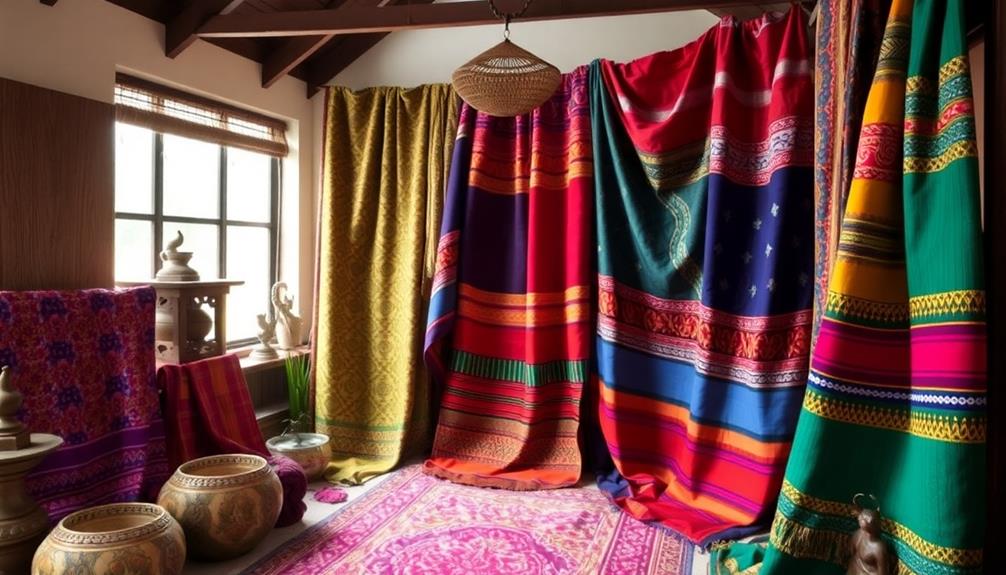
When you explore Ulos, you'll uncover its deep historical roots within the Batak community, where it's been woven since the 14th century.
This traditional fabric, much like the vibrant Indonesian Decor Masks, plays a significant role in cultural expression and storytelling.
Each design carries symbolism and meaning, reflecting significant life events and cultural beliefs.
Historical Roots and Traditions
Ulos fabric stands as a symbol to the rich cultural heritage of the Batak community, weaving together history, tradition, and identity. Produced since the 14th century, Ulos is much more than just a textile; it's an essential part of cultural traditions that mark significant life events.
You'll find Ulos used in weddings and funerals, where it conveys social status and strengthens familial connections. These beautiful fabrics often feature vibrant colors and intricate patterns, similar to traditional Indonesian Decorative Pillows, enhancing the aesthetic of any space while reflecting cultural heritage.
In 2014, Ulos was recognized as an intangible cultural heritage, highlighting its importance in Batak life. Each type of Ulos serves a unique purpose—like Ulos Antak-Antak for mourning or Ulos Bolean for blessings—underscoring its role in rituals.
The introduction of hand looms from India enriched the production methods, showcasing a historical exchange of textile techniques that influenced the craft.
The intricate patterns and motifs in Ulos reflect deep symbolism, representing protection and strength, while connecting the maker with the wearer. By producing and gifting these traditional fabrics, the Batak community not only preserves ancient weaving techniques but also fosters unity and cultural pride.
Engaging with Ulos means stepping into a living history that resonates through generations.
Symbolism in Design
Amidst the vibrant tapestry of Indonesian culture, the symbolism woven into Ulos fabric plays an essential role in expressing identity and values. Produced by the Batak community since the 14th century, Ulos isn't just a fabric; it's a crucial cultural symbol. Each type—like Ulos Antak-Antak and Ulos Bolean—carries distinct meanings, carefully selected for rituals and ceremonies, including weddings and funerals. This tradition reflects the community's deep-rooted beliefs and practices, much like the significance of traditional Indonesian housing, which also embodies cultural identity.
The intricate designs and weaving techniques have been meticulously passed down through generations, preserving the rich cultural heritage of the Batak people. Recognized as an intangible cultural heritage in 2014, Ulos embodies not only the values but also the social status within the community.
In contemporary fashion, designers are making waves by incorporating Ulos into modern designs, showcasing its adaptability without losing its traditional essence. This blend of old and new highlights the ongoing importance of symbolism in design, allowing you to appreciate how these traditional Indonesian fabrics can communicate profound stories and meanings.
Embracing Ulos means embracing a piece of history and cultural significance that transcends time.
The Allure of Songket Fabrics

When you explore the world of songket fabrics, you're not just admiring beautiful textiles; you're connecting with a rich cultural heritage that dates back centuries.
These exquisite fabrics often feature intricate designs that tell stories of local myths and traditions, much like the importance of Indonesian decor masks.
The unique weaving techniques employed by skilled artisans make each piece a one-of-a-kind treasure.
Today, modern designers are seamlessly integrating songket into contemporary fashion, showcasing its timeless appeal.
Cultural Heritage Significance
Often regarded as a symbol of luxury and cultural heritage, Songket fabrics captivate with their intricate designs and rich history. These traditional fabrics, especially from Lombok and Palembang, are more than mere textiles; they embody the essence of Indonesian culture. The motifs woven into Songket Lombok reflect the values of the Sasak people and often play a role in ceremonies, signifying social status and cultural identity.
The historical significance of Songket Palembang traces back to the 7th century, showcasing royal fashion and artistry. Each pattern is imbued with meanings like protection, prosperity, and identity, making them crucial in traditional celebrations.
To illustrate the allure and significance of these fabrics, consider the table below:
| Fabric Origin | Cultural Significance | Designers' Influence |
|---|---|---|
| Lombok | Reflects Sasak cultural values | Modern adaptations |
| Palembang | Ties to royal fashion | Global appeal |
| General | Represents protection and identity | Contemporary collections |
| Historical | Used in traditional ceremonies | Fusion with modern styles |
| Revival | Adaptability in fashion | Preservation of heritage |
Through modern interpretations, designers are ensuring that the cultural heritage of Songket remains alive and relevant.
Unique Weaving Techniques
While the beauty of Songket fabrics lies in their vibrant colors and intricate designs, it's the unique weaving techniques that truly set them apart. Originating from Indonesia, these traditional fabrics incorporate metallic threads, often made from gold or silver, which creates a luxurious, eye-catching appearance.
When you explore Songket Lombok, you'll notice how colorful cotton threads blend with metallic accents, with each motif reflecting the cultural values and traditions of the Lombok community. Additionally, the incorporation of traditional batik patterns in various designs adds another layer of depth to these beautiful textiles.
On the other hand, Songket Palembang, dating back to the 7th century, showcases elaborate patterns that symbolize protection and social status, originally worn in royal fashion during the Sriwijaya Kingdom. The labor-intensive process behind crafting these textiles involves time-honored techniques passed down through generations, ensuring that each piece isn't only beautiful but also a rich representation of cultural heritage.
As you admire Songket fabrics, remember that they serve more than just aesthetic purposes. They play significant cultural roles, often worn during ceremonial occasions, symbolizing the wearer's identity and social standing within their community.
This unique blend of artistry and tradition truly makes Songket fabrics a fascinating aspect of Indonesian culture.
Modern Fashion Integration
Integrating Songket fabrics into modern fashion brings an enchanting blend of tradition and contemporary style. As a fashion designer, you'll appreciate how these traditional fabrics, characterized by intricate gold and silver thread weaving, elevate your creations.
The vibrancy and unique motifs of Songket Lombok and Songket Palembang not only reflect rich cultural narratives but also provide a canvas for authentic storytelling within your contemporary creations. Additionally, the growing interest in sustainable practices within the interior design community, such as the emphasis on sustainable craftsmanship in Balinese furniture, aligns seamlessly with the ethos of Songket production methods.
You'll find that Songket's versatility allows you to craft stunning dresses and accessories, bridging the gap between heritage and modern trends. Plus, there's a growing emphasis on sustainability in the fashion world, and Songket production methods align perfectly with this. By utilizing traditional hand-weaving techniques, you're supporting local artisans and promoting ethical fashion practices.
With the increasing global recognition of Indonesian textiles, collaborating with local artisans can enhance the visibility of these exquisite fabrics on international fashion platforms. This fusion of traditional craftsmanship with modern aesthetics creates a unique allure that sets your designs apart.
Embrace Songket fabrics, and watch as your designs captivate audiences with their luxurious appeal and rich cultural significance.
Innovations in Tenun Techniques
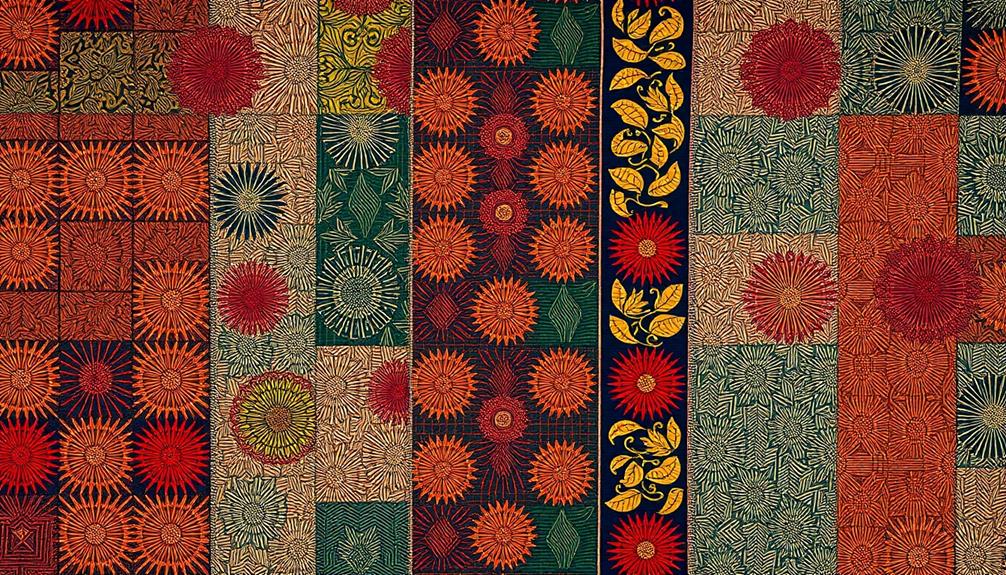
Innovations in Tenun techniques are reshaping the landscape of traditional Indonesian fabrics, blending age-old practices with contemporary needs. By embracing sustainability, artisans now use natural fibers and eco-friendly materials, ensuring that cultural authenticity remains intact. These techniques not only enhance the visual appeal but also reflect a commitment to the environment.
| Technique | Traditional Aspect | Modern Interpretation |
|---|---|---|
| Natural Dyes | Passed down through generations | Broader color palette |
| Intricate Weaving Methods | Distinct regional patterns | Unique fabric variations |
| Advanced Dyeing Techniques | Cultural motifs | Enhanced visual appeal |
| New Textures & Yarn | Reflective of heritage | Cater to modern fashion demands |
Artisans are experimenting with textures and yarn selections, creating fabrics that speak to today's fashion sensibilities while preserving traditional craftsmanship. This collaboration between local artisans and contemporary designers results in innovations in Tenun techniques that resonate with younger audiences and global markets. The fusion of tradition and modernity in these fabrics offers a fresh perspective on Indonesia's rich textile heritage, making them more appealing than ever.
Reviving Traditional Lurik

Lurik is making a vibrant comeback, enchanting the hearts of fashion enthusiasts and preserving an essential piece of Indonesian heritage. This traditional handwoven fabric from Java, known for its striking striped patterns, has deep roots dating back to the 16th century. Once reserved for Javanese aristocrats, lurik symbolizes cultural identity and status.
The resurgence of lurik aligns beautifully with the principles of traditional Indonesian style home decor, which emphasizes harmony with nature and the use of local materials.
In recent years, designers have embraced reviving traditional lurik, integrating it into contemporary fashion. By doing so, they've made this beautiful fabric accessible to younger generations, who crave unique and sustainable clothing options. You'll find lurik in a variety of garments, from shirts and dresses to accessories, showcasing its versatility and charm.
This revival not only brings a sense of modernity to traditional fabrics but also supports local artisans and communities. By choosing lurik, you're playing a part in preserving ancient weaving techniques and fostering economic growth. Supporting traditional craftsmanship helps maintain the cultural significance of this fabric, ensuring it continues to thrive in today's fashion landscape.
Sustainability in Fabric Production
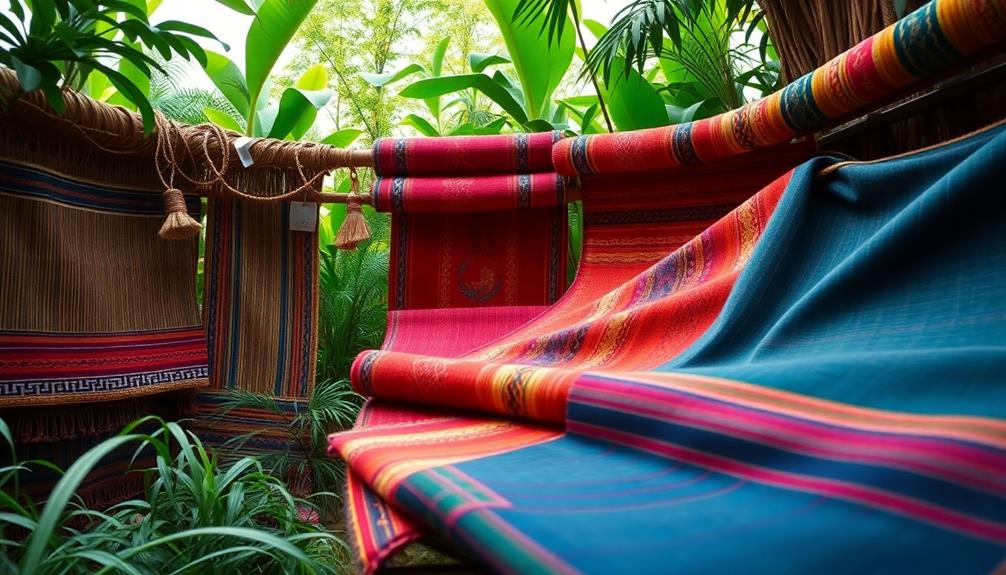
In the domain of traditional Indonesian fabrics, sustainability shines as a core principle guiding the production process. You'll find that artisan production methods, like those used for batik and tenun, rely on skills passed down through generations, often without electricity. This not only makes the process environmentally friendly but also helps preserve cultural heritage, much like the Balinese design characteristics which emphasize sustainability and craftsmanship.
Many of these traditional fabrics utilize organic or azo-free dyes, minimizing harmful chemical impacts on artisans and consumers alike. This commitment to sustainability aligns perfectly with the slow fashion movement, which champions durability and craftsmanship, encouraging you to invest in pieces that'll last a lifetime instead of succumbing to fast fashion trends.
Moreover, artisan production supports local economies, providing fair wages and fostering community growth. Brands like Nost collaborate closely with artisan families, ensuring that the intricate craftsmanship of traditional textiles is both respected and preserved.
When you choose these sustainable fabrics, you're not just wearing a piece of art; you're also supporting a movement that values environmental stewardship and the well-being of artisans. It's a choice that reflects your commitment to sustainability while celebrating the beauty of traditional fabrics.
Modern Interpretations of Batik

Modern interpretations of batik showcase a vibrant fusion of traditional craftsmanship and contemporary design, making it more accessible and appealing to younger audiences.
Designers like Tan Sheau Yun and brands such as Nost are leading this movement, successfully blending batik patterns with modern loungewear and outfits. By emphasizing sustainability, they not only maintain cultural significance but also cater to the values of today's consumers.
This evolution is reminiscent of the modern tropical aesthetics in Bali, where natural materials and eco-friendly practices play an essential role in contemporary design.
Here are three exciting aspects of modern batik:
- Innovative Techniques: New dyeing methods and fabric textures breathe life into traditional batik, allowing for fresh designs that resonate with modern tastes.
- Cultural Appreciation: Exhibitions like "At Batik Kita" highlight both historical and contemporary batik, fostering a deeper understanding and appreciation of this art form among diverse audiences.
- Social Media Influence: Fashion influencers on social media platforms are championing batik, encouraging designers to experiment with traditional elements while promoting sustainability and uniqueness.
Through these modern interpretations, batik continues to evolve, ensuring it remains relevant and cherished in today's fashion landscape.
Global Influence of Indonesian Textiles

The global influence of Indonesian textiles, especially batik, has surged dramatically in recent years, capturing the attention of fashion enthusiasts and designers alike. Since UNESCO recognized batik as an Intangible Cultural Heritage of Humanity in 2009, its cultural significance and craftsmanship have gained prominence on the world stage.
Designers like Iwan Tirta have been instrumental in elevating batik within haute couture, showcasing its versatility and beauty in high-end collections.
Celebrities such as Angelina Jolie and Kate Middleton have further amplified batik's visibility, flaunting these stunning designs and attracting a diverse audience. This blend of tradition and modernity illustrates how batik seamlessly integrates into contemporary fashion.
Moreover, collaborations between international designers and Indonesian artisans foster a deeper appreciation for the intricate craftsmanship behind these textiles. This partnership not only promotes cultural exchange but also creates economic opportunities for local communities, allowing them to sustain their heritage.
As you explore the world of fashion, you'll find that Indonesian textiles, particularly batik, offer a rich narrative that connects history with modern style, making them irresistible to those who value authenticity and artistry.
Future Trends in Fabric Design
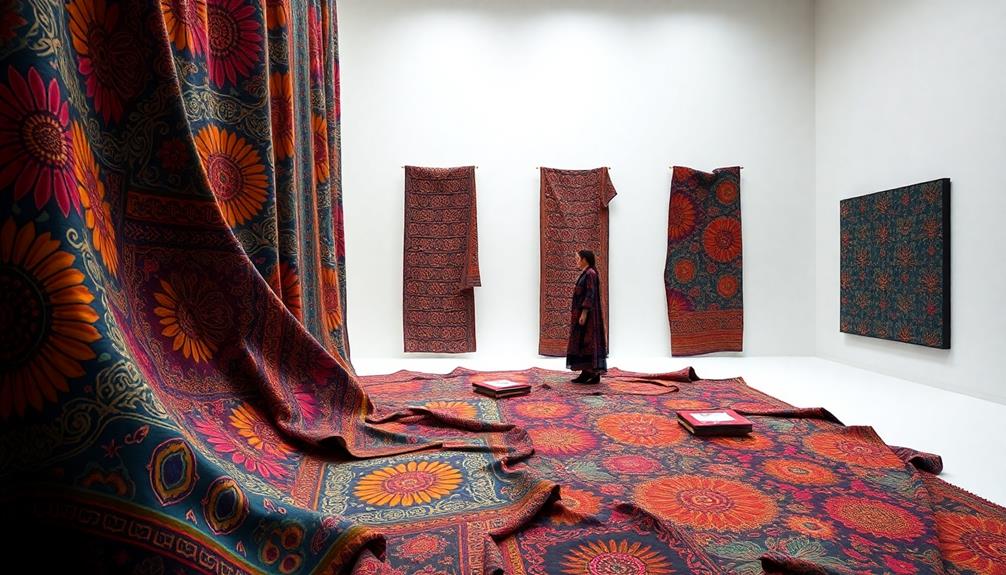
As designers embrace the rich heritage of traditional Indonesian fabrics, they're reshaping the future of fabric design with innovative approaches that blend culture and contemporary style.
The increasing focus on sustainability and ethical practices is driving this trend, as more brands integrate traditional textiles like batik, songket, and tenun into their collections.
Here are three key trends to watch:
- Modern Silhouettes: Designers are reinterpreting traditional fabrics into fresh, modern shapes, appealing to younger audiences hungry for unique fashion choices.
- Vibrant Colors: Expect to see bold colors and patterns that celebrate the artistry of traditional techniques while making striking statements in contemporary wardrobes.
- Collaborative Efforts: Partnerships between local artisans and designers are on the rise, allowing traditional techniques to evolve while preserving their cultural significance.
The slow fashion movement further emphasizes using traditional fabrics, supporting artisan communities and promoting sustainability.
As these practices grow, you'll find that many pieces made from traditional fabrics not only tell a story but also foster a deeper connection between the wearer and the rich heritage they represent.
Frequently Asked Questions
What Is the Famous Fabric Design of Indonesia?
The famous fabric design of Indonesia is batik. You'll admire its intricate wax-resist dyeing techniques and diverse patterns, each carrying deep cultural meanings that reflect Indonesia's rich heritage and artistic craftsmanship.
What Are the Traditional Textiles of Indonesia?
You might think Indonesia's textiles are just fabrics, but they're rich cultural stories. Batik, ulos, songket, tenun, lurik, and tapis each embody unique traditions, techniques, and meanings, reflecting the vibrant heritage of local communities.
Why Is Indonesia a Major Manufacturer of Clothing?
Indonesia's a major clothing manufacturer because it offers abundant natural fibers, skilled artisans, and a rich cultural heritage. You'll find a diverse range of traditional textiles that meet modern fashion demands while promoting sustainable practices.
What Is the Most Popular Textile of Indonesia?
Amidst vibrant markets and serene villages, you'll find batik, Indonesia's most beloved textile. This intricate fabric weaves stories through its designs, reflecting rich traditions and cultural heritage, enchanting everyone who encounters its beauty.
Conclusion
As you explore the vibrant world of Indonesian textiles, think of each fabric as a storyteller, weaving tales of history, culture, and innovation. Just like a river that flows through time, batik, ulos, and songket carry the essence of their origins into the modern world. With sustainability at the forefront, these fabrics are not just materials; they're threads connecting the past to the future, inviting you to wear a piece of heritage and art in every stitch.
